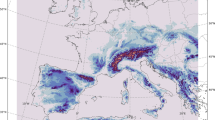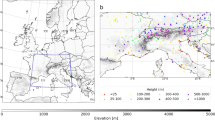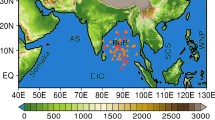Abstract
Using the Weather Research and Forecasting (WRF) model, this paper analyzes the spatiotemporal features of heat waves in 20-year regional climate simulations over East Asia, and investigates the capability of WRF to reproduce observational heat waves in China. Within the framework of the Coordinated Regional Climate Downscaling Experiment (CORDEX), the WRF model is driven by the ERA-Interim (ERAIN) reanalysis, and five continuous simulations are conducted from 1989 to 2008. Of these, four runs apply the interior spectral nudging (SN) technique with different wavenumbers, nudging variables and nudging coefficients. Model validations show that WRF can reasonably reproduce the spatiotemporal features of heat waves in China. Compared with the experiment without SN, the application of SN is effectie on improving the skill of the model in simulating both the spatial distributions and temporal variations of heat waves of different intensities. The WRF model shows advantages in reproducing the synoptic circulations with SN and therefore yields better representations for heat wave events. Besides, the SN method is able to preserve the variability of large-scale circulations quite well, which in turn adjusts the extreme temperature variability towards the observation. Among the four SN experiments, those with stronger nudging coefficients perform better in modulating both the spatial and temporal features of heat waves. In contrast, smaller nudging coefficients weaken the effects of SN on improving WRF’s performances.















Similar content being viewed by others
References
Berg P, Feldmann H, Panitz HJ (2012) Bias correction of high resolution regional climate model data. J Hydrol 448:80–92
Black E et al (2004) Factors contributing to the summer 2003 European heatwave. Weather 59(8):217–223
Chen F, Dudhia J (2001) Coupling an advanced land surface-hydrology model with the Penn State-NCAR MM5 modeling system Part I: model implementation and sensitivity. Mon Wea Rev 129(4):569–585
Collins WD, Rash PJ, Boville BA, Hack JJ, McCaa JR, Williamson DL, Kiehl JT, Briegleb B (2004) Description of the NCAR community atmosphere model (CAM 3.0). Tech Rep NCAR TN-464 + STR, National Center for Atmospheric Research
Davies HC (1976) Lateral boundary formulation for multilevel prediction models. Q J R Meteorol Soc 102(432):405–418
Dee DP, Uppala SM, Simmons AJ et al (2011) The ERA-Interim reanalysis: configuration and performance of the data assimilation system. Q J R Meteorol Soc 137(656):553–597
Ding T, Ke Z (2015) Characteristics and changes of regional wet and dry heat wave events in China during 1960–2013. Theoret Appl Climatol 122(3–4):651–665
Ding T, Qian W (2011) Geographical patterns and temporal variations of regional dry and wet heatwave events in China during 1960–2008. Adv Atmos Sci 28:322–337
Ding T, Qian W, Yan Z (2010) Changes in hot days and heat waves in China during 1961–2007. Int J Climatol 30(10):1452–1462
Dole R et al (2011) Was there a basis for anticipating the 2010 Russian heat wave?. Geophys Res Lett 38(6)
Dosio A (2017) Projection of temperature and heat waves for Africa with an ensemble of CORDEX regional climate models. Clim Dyn 49(1–2):493–519
Fischer EM, Schär C (2010) Consistent geographical patterns of changes in high-impact European heatwaves. Nat Geosci 3:398–403
Fischer EM, Seneviratne SI, Lüthi D (2007) Contribution of land-atmosphere coupling to recent European summer heat waves. Geophys Res Lett 34(6): L06707. https://doi.org/10.1029/2006GL029068
Grotjahn R, Black R, Leung R et al (2016) North American extreme temperature events and related large scale meteorological patterns: a review of statistical methods, dynamics, modeling, and trends. Clim Dyn 46(3–4):1151–1184
Guo X, Huang J, Luo Y et al (2017) Projection of heat waves over China for eight different global warming targets using 12 CMIP5 models. Theoret Appl Climatol 128(3):507–522
Hong SY, Noh Y, Dudhia J (2006) A new vertical diffusion package with an explicit treatment of entrainment processes. Mon Weather Rev 134:2318–2341
Intergovernmental Panel on Climate Change (2014) Climate change 2014–impacts, adaptation and vulnerability: regional aspects. Cambridge University Press, Cambridge
Ji Z, Kang S (2015) Evaluation of extreme climate events using a regional climate model for China. Int J Climatol 35(6):888–902
Jiang ZH, Song J, Li L, Chen WL, Wang ZF, Wang J (2012) Extreme climate events in China: IPCC-AR4 model evaluation and projection. Clim Change 110(1–2):385–401
Jin CS, Cha DH, Lee DK et al (2016) Evaluation of climatological tropical cyclone activity over the western North Pacific in the CORDEX-East Asia multi-RCM simulations. Clim Dyn 47(3–4):765–778
Kain JS, Fritsch JM (1990) A one-dimensional entraining/detraining plume model and its application in convective parameterization. J Atmos Sci 47:2784–2802
Laprise R, Kornic D, Rapaić M et al (2012) Considerations of domain size and large-scale driving for nested regional climate models: impact on internal variability and ability at developing small-scale details. Clim Change 21:181–199. https://doi.org/10.1007/978-3-7091-0973-1_14
Lhotka O, Kyselý J (2015) Spatial and temporal characteristics of heat waves over Central Europe in an ensemble of regional climate model simulations. Clim Dyn 45(9–10):2351–2366
Li Q, Liu X, Zhang H, Peterson TC, Easterling DR (2004) Detecting and adjusting temporal in-homogeneity in Chinese mean surface air temperature data. Adv Atmos Sci 21(2):260–268
Li D, Zou L, Zhou T (2017) Regional air-sea coupled model simulation for two types of extreme heat in North China. Clim Dyn. https://doi.org/10.1007/s00382-017-3738-2
Lim KSS, Hong SY (2010) Development of an effective double- moment cloud microphysics scheme with prognostic cloud con-densation nuclei (CCN) for weather and climate models. Mon Weather Rev 138:1587–1612
Luo M, Lau NC (2017) Heat waves in southern china: synoptic behavior, long-term change, and urbanization effects. J Clim 30(2):703–720
Matsueda M (2011) Predictability of Euro-Russian blocking in summer of 2010. Geophys Res Lett 38(6):L06801. https://doi.org/10.1029/2010GL046557
Meehl GA, Tebaldi C (2004) More intense, more frequent, and longer lasting heat waves in the 21st century. Science 305:994–997
Niu RY, Guo WH (1998) The characteristic analysis of high temperature in China in the summer of 1997. Meteorology 24(8):44–49
Omrani H, Drobinski P, Dubos T (2015) Using nudging to improve global-regional dynamic consistency in limited-area climate modeling: what should we nudge? Clim Dyn 44(5–6):1627–1644
Ouzeau G, Soubeyroux JM, Schneider M et al (2016) Heat waves analysis over France in present and future climate: application of a new method on the EURO-CORDEX ensemble. Clim Serv 4:1–12
Perkins SE (2015) A review on the scientific understanding of heatwaves—their measurement, driving mechanisms, and changes at the global scale. Atmos Res 164:242–267
Perkins SE, Alexander LV (2013) On the measurement of heat waves. J Clim 26(13):4500–4517
Reynolds RW, Smith TM (1994) Improved global sea surface temperature analyses using optimum Interpolation. J Clim 7(6):929–948
Russo S et al (2014) Magnitude of extreme heat waves in present climate and their projection in a warming world. J Geophys Res Atmos 119(22):12500–12512. https://doi.org/10.1002/2014JD022098
Schär C, Vidale PL, Luthi D, Frei C, Haberli C, Liniger MA, Appenzeller C (2004) The role of increasing temperature variability in European summer heatwaves. Nature 427:332–336
Seneviratne SI, Nicholls N, Easterling D et al (2012) Changes in climate extremes and their impacts on the natural physical environment. In: Managing the risks of extreme events and disasters to advance climate change adaptation. A special report of working groups I and II of the intergovernmental panel on climate change. Cambridge University Press, Cambridge, pp 109–230
Sillmann J, Kharin VV, Zhang X et al (2013) Climate extremes indices in the CMIP5 multimodel ensemble: Part 1. Model evaluation in the present climate. J Geophys Res 118(4):1716–1733
Skamarock WC et al (2008) A description of the Advanced Research WRF version 3. NCAR Tech. Note NCAR/TN-475 + STR, p 113
Stéfanon M et al (2012) Effects of interactive vegetation phenology on the 2003 summer heat waves. J Geophys Res 117(D24):3091–3108
Storch HV, Langenberg H, Feser F (2000) A spectral nudging technique for dynamical downscaling purposes. Mon Weather Rev 128:3664–3673
Sun Y et al (2014) Rapid increase in the risk of extreme summer heat in Eastern China. Nat Clim Chang 4(12):1082–1085
Tang J, Song S, Wu JA (2010) Impacts of the spectral nudging technique on simulation of the East Asian summer monsoon. Theoret Appl Climatol 101(1–2):41–51
Tang J, Wang S, Niu X et al (2016) Impact of spectral nudging on regional climate simulation over CORDEX East Asia using WRF. Clim Dyn 48(7–8):2339–2357
Taylor KE (2001) Summarizing multiple aspects of model performance in a single diagram. J Geophys Res 106(D7):7183–7192
Vautard R, Gobiet A, Jacob et al (2013) The simulation of European heat waves from an ensemble of regional climate models within the EURO-CORDEX project. Clim Dyn 41(9–10):2555–2575
Wang W, Zhou W, Li X, Wang X, Wang D (2016) Synoptic-scale characteristics and atmospheric controls of summer heat waves in China. Clim Dyn 46(9–10):2923–2941
Wang P, Tang J, Sun X et al (2017a) Heat waves in china: definitions, leading patterns, and connections to large-scale atmospheric circulation and SSTs. J Geophys Res Atmos 122:10679–10699. https://doi.org/10.1002/2017JD027180
Wang P, Tang J, Wang S et al (2017b) Regional heatwaves in China: a cluster analysis. Clim Dyn 50(5–6):1901–1917
Wang J, Yan Z, Quan XW et al (2017c) Urban warming in the 2013 summer heat wave in eastern China. Clim Dyn 48(9–10):3015–3033
Xia J, Tu K, Yan Z, Qi Y (2016) The super-heat wave in eastern China during July–August 2013: a perspective of climate change. Int J Climatol 36(3):1291–1298
You Q, Jiang Z, Kong L et al (2016) A comparison of heat wave climatologies and trends in China based on multiple definitions. Clim Dyn 1–15
Zou L, Zhou T, Peng D (2016) Dynamical downscaling of historical climate over CORDEX East Asia domain: a comparison of regional ocean atmosphere coupled model to standalone RCM simulations. J Geophys Res 121(4):1442–1458
Acknowledgements
This work is supported by the National Key R&D Program of China (2017YFA0603803 and 2016YFA0600303) and the National Natural Science Foundation of China (41375075, 91425304 and 41775074). The numerical calculations in this paper have been done on the computing facilities in the High Performance Computing Center (HPCC) of Nanjing University. The authors also acknowledge with thanks the ECMWF for providing the ERA-interim reanalysis data as driving fields in the simulations. And we declare that we have no conflict of interest.
Author information
Authors and Affiliations
Corresponding authors
Rights and permissions
About this article
Cite this article
Wang, P., Tang, J., Sun, X. et al. Spatiotemporal characteristics of heat waves over China in regional climate simulations within the CORDEX-EA project. Clim Dyn 52, 799–818 (2019). https://doi.org/10.1007/s00382-018-4167-6
Received:
Accepted:
Published:
Issue Date:
DOI: https://doi.org/10.1007/s00382-018-4167-6




